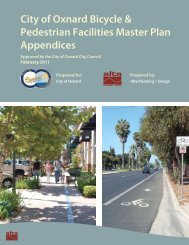Santa Clara River Trail Final Master Plan - Development Services ...
Santa Clara River Trail Final Master Plan - Development Services ...
Santa Clara River Trail Final Master Plan - Development Services ...
Create successful ePaper yourself
Turn your PDF publications into a flip-book with our unique Google optimized e-Paper software.
<strong>Santa</strong> <strong>Clara</strong> <strong>River</strong> <strong>Trail</strong> <strong>Plan</strong><br />
Chapter 2: Summary of Gap Analysis, Geographic<br />
Impediments and Alternatives Analysis<br />
Gap Analysis<br />
This section discusses the identification of gaps on the <strong>Santa</strong> <strong>Clara</strong> <strong>River</strong> <strong>Trail</strong> within the City of Oxnard.<br />
The text first defines common trail gaps. Various gap closure measures used throughout the United<br />
States and other countries are listed, that could be applied in Oxnard. The text concludes with a<br />
procedure for identifying <strong>Santa</strong> <strong>Clara</strong> <strong>River</strong> <strong>Trail</strong> gaps.<br />
Defining <strong>Trail</strong> Gaps<br />
<strong>Trail</strong> gaps exist in various forms, ranging from short “missing links” on a specific street or path corridor,<br />
to larger geographic areas with few or no facilities at all. Determining specifically what constitutes a<br />
“gap” requires setting parameters for the walkway and bikeway networks and determining which<br />
activity centers require direct links to the networks. For example, the desired bikeway network may be a<br />
grid with approximately two-mile spacing in developed areas—a network density of approximately one<br />
mile of bikeway per square mile. Under this scenario, areas where parallel bikeways are more than two<br />
miles apart would be identified as gaps. Likewise, if it is determined that all transit stations should be<br />
directly served by the walkway network, any missing walkways within a half-mile of a transit station<br />
would constitute a gap. Gaps can then be organized based on length and other characteristics. Gaps can<br />
be classified into five main categories:<br />
<br />
Spot gaps: Spot gaps refer to point-specific locations lacking dedicated facilities or other<br />
treatments to accommodate safe and comfortable pedestrian or bicycle travel. Spot gaps<br />
primarily include intersections and other areas with potential conflicts with motor vehicles.<br />
Examples include bike lanes on a major street “dropping” to make way for right turn lanes at<br />
intersection, or a lack of intersection crossing treatments for pedestrians on a route or sidewalk<br />
as they approach a major street.<br />
<br />
<br />
<br />
Connection gaps: Connection gaps are missing segments (¼ mile long or less) on a clearly<br />
defined and otherwise well-connected walkway or bikeway. Major barriers standing between<br />
destinations and clearly defined routes also represent connection gaps. Examples include bike<br />
lanes on a major street “dropping” for several blocks to make way for on-street parking; a<br />
discontinuous sidewalk along a street; or a freeway standing between a major pedestrian or<br />
bicycle route and a school.<br />
Lineal gaps: Similar to connection gaps, lineal gaps are ½- to one-mile long missing link<br />
segments on a clearly defined and otherwise well-connected walkway or bikeway.<br />
Corridor gaps: On clearly defined and otherwise well-connected bikeways, corridor gaps are<br />
missing links longer than one mile. These gaps will sometimes encompass an entire street<br />
corridor where bicycle facilities are desired but do not currently exist (does not apply for<br />
wa lkwa y gaps).<br />
City of Oxnard | 37
















